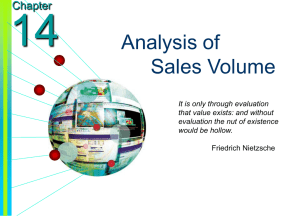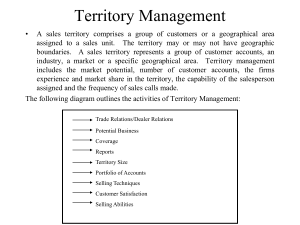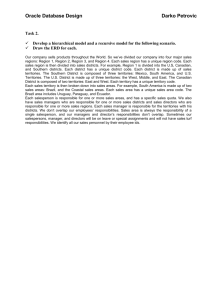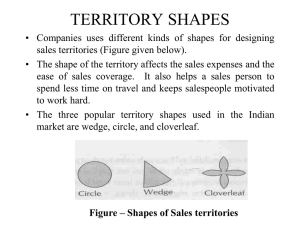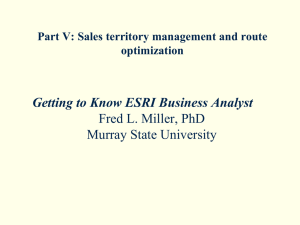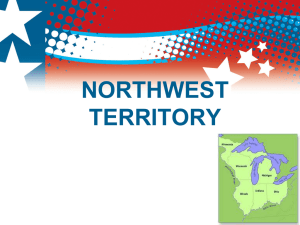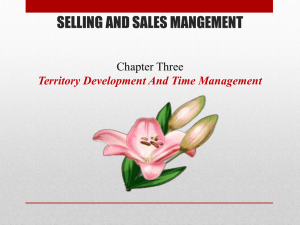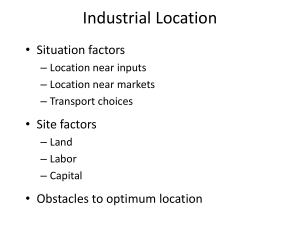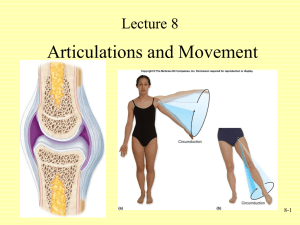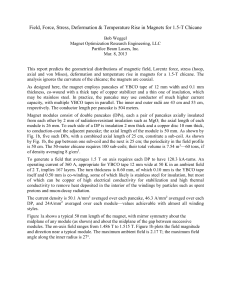SMCh14 - Marketing Club UMT
advertisement
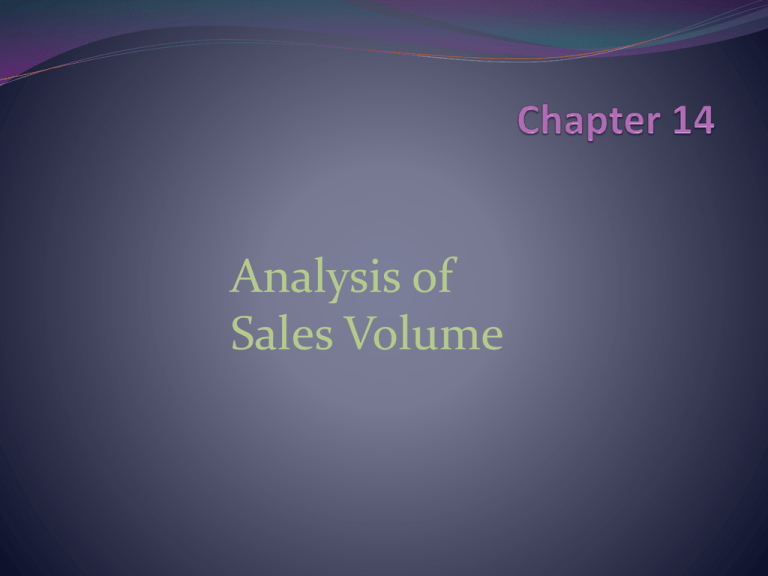
Analysis of Sales Volume Learning Objectives Strategic relationship between Planning and Evaluation Sales Force Performance Evaluation Bases for Analyzing Sales Volume Sales Force Automation Interrelationship of Planning, Implementation, and Evaluation Planning Set goals Determine strategies & tactics Evaluation Implementation Compare goals and results Organize Explain variances Staff Operate Planning, implementation and evaluation are conducted in an interrelated and continuous manner. Planning, Implementation and Evaluation (1)Effective planning, (2)implementation and (3) evaluation. Evaluation follows and precedes planning. Effective evaluation will tell: Whether its plan has worked To what degree it has been successful What the reasons are for the plan’s success or failure The Evaluation Process (Fig 14-2) To Find Out: What happened Why it happened What to do about it A marketing audit – a comprehensive, periodic review and evaluation of the marketing function in an organization – its marketing goals, strategies, and performance. (e.g., appraisal of the organization, personnel and tactics employed to implement the strategies and reach the goals). Sales Force Performance Evaluation MPA may be taken to correct the misdirected marketing effort found in many companies. Evaluation of sales performance covers: The analysis of sales volume (SVA) – (is a careful study of a company’s records of income statement in the net sales section). Marketing cost analysis (MCA)(a study of marketing expenses determine the profitability of various marketing segments in an organization) and marketing profitability analysis (MPA) – SVA+MCA=MPA Various analytical measures used to evaluate an individual salesperson’s performance Nature of Misdirected Marketing Effort A company does not enjoy the same rate of net profit on every sale. In most firms a large proportion of the orders accounts for a small share of the profits. The 80-20 Principle (the relationship between selling units and profits). 80 percent of the orders, customer, territories, or products contributes only 20 percent of the sales volume or profit. Demonstrates misplacement of marketing efforts. Because lack of sufficient detailed information, many executives are unaware of misdirected marketing effort in their firms. Total Sales Figures May Hide Significant Problems (Fig. 14-3) Sales Volume Total Territory A Time (years) Many have shown satisfied overall sales, however, when totals were subdivided by territory or products, serious weaknesses may be discovered. Bases for Analyzing Sales Volume Total Sales Volume – the combined sales of all products in all territories for all customers. Sales by Territories – can identify further (e.g., which territories are strong) Sales by Products – few products may bring most of the volume. Sales by Customer Classifications – can analyze its volume by customer groups in several ways (e.g., industry basis, channels of distributions) Information Used In Analysis of Total Sales Volume, Colorado Ski Company (Fig. 14-4) Year 2002 2001 2000 1999 1998 1997 1996 1995 1994 1993 Company Volume Industry Volume Company’s Share (in millions) (in millions) of Market $27.0 $360 7.5% 25.2 390 6.4 23.4 360 6.5 20.4 312 7.0 21.0 300 8.2 19.2 234 8.3 19.8 240 8.9 19.2 216 8.9 18.0 180 10.0 15.0 150 10.0 Analysis of Territorial Sales Volume in Five-Territory Western Division, Colorado Ski Company (Fig. 14-5) Market Dollar Index Sales Goals Actual Sales Performance Variation Territory (percent) ($000) ($000) Percentage ($000) A 27% $3,645 $2,700 74% $-945 B 22 2,970 3,690 124 +720 C 15 2,025 2,484 123 +459 D 20 2,700 2,556 95 -144 E 16 2,160 2,070 96 -90 Total 100% $13,500 $13,500 Analysis of Product Sales Performance in Two Territories, Colorado Ski Company (Fig. 14-6) Territory A ($000) Product Goal Actual Variation Skis $1,629 $1,710 $+81 Accessories 270 234 -36 Pants 900 360 -540 Parkas 846 396 -450 Total $3,645 $2,700 $-945 Territory B ($000) Goal Actual Variation $1,263 $1,620 $+357 222 360 +138 765 1,080 +315 720 630 -90 $2,970 $3,690 $+720 Customer Probability Cube (Fig. 14-7) Q4 Q3 Q2 0.9 Q1 Customers C1 0.2 0.5 0.1 0.9 0.2 0.5 0.1 P1 P2 P3 P4 0.1 C2 ... Cn Products Shows salespeople what to sell, when and to whom… Sales Force Automation Typically a single part of an overall CRM (Customer Relationship Management) system Analyzes information from a variety of the firm’s different business functions (e.g. sales, marketing, accounting, purchasing, manufacturing). Salespeople are sometimes resistant to SFA initiatives. Thank you
